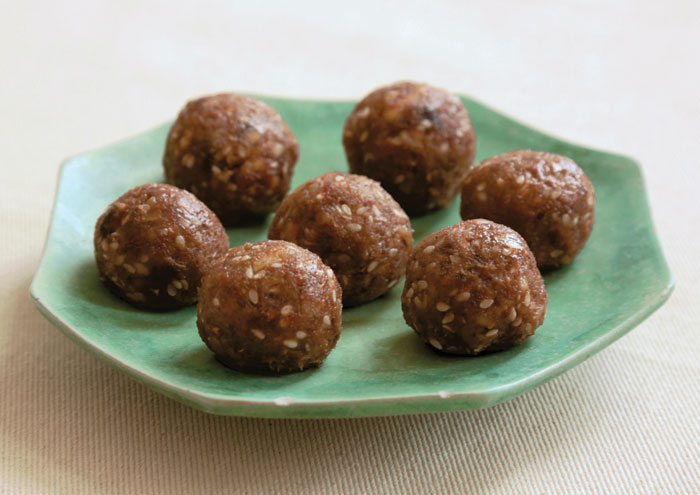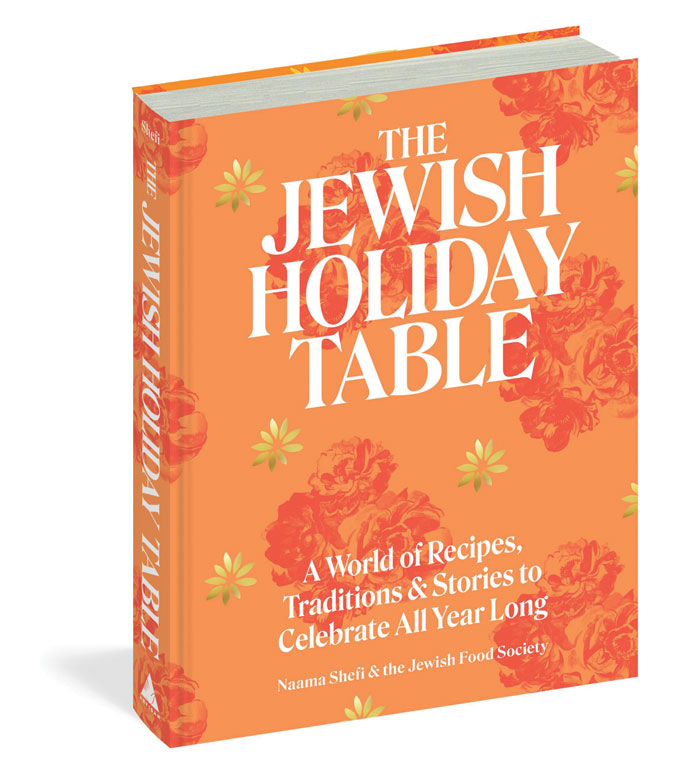 Rinot Tzadok’s Charoset Balls
Rinot Tzadok’s Charoset Balls “The Jewish Holiday Table” is “a love letter to our diverse culinary heritage,” Naama Shefi told the Journal. Shefi is founder of the Jewish Food Society, a non-profit that works to preserve, celebrate and revitalize Jewish culinary heritage from around the world.
In March, Shefi and the Jewish Food Society published their first cookbook: “The Jewish Holiday Table: A World of Recipes, Traditions & Stories to Celebrate All Year Long,” a vibrant collection of 135 recipes and stories, with beautiful photos to match. It is as much a celebration of resilience, tradition and joy, as it is a resource for holiday cooking.
“The book celebrates Jewish holiday traditions from families around the world in places as far apart as Argentina, Hungary, India and Italy,” Shefi, who is also founder of Asif: Culinary Institute of Israel, said.
“My good friend Mitchell Davis once said that food without a story is just calories. More than simply a recipe book, this is a book that celebrates Jewish stories and honors the rich tapestry of our heritage.”
Since 2017, the Jewish Food Society has been building the largest archive of family recipes and histories. This book is a showcase for their deep research and rich cultural food history, and includes recipes and stories that have been passed down through generations.
Shefi says the book was a collaborative process with her core team at Jewish Food Society. This includes co-author Devra Ferst, their archive’s editor; creative director Amanda Dell and award-winning photographer Penny de Los Santos; as well as the recipe developers, testers and the featured families.
“We did a deep dive to understand where their traditions come from, how they celebrate different holidays and how they set their own tables.” – Naama Shefi
“We did a deep dive to understand where their traditions come from, how they celebrate different holidays and how they set their own tables,” Shefi said. “There is nothing more powerful than hearing these stories in the families’ own words.”
 The book is organized by seasons and their respective holidays, closely following the Jewish agricultural calendar. There’s a Milanese Hanukkah menu, recipes for an Iraqi Purim party, a festive French Shabbat and a Moroccan Mimouna gathering to mark the end of Passover. There are also stories of a long journey via camel in Yemen, survival in Ukraine, a Bukharian grandmother on YouTube and women baking holiday sweets together in what’s now Zimbabwe.
The book is organized by seasons and their respective holidays, closely following the Jewish agricultural calendar. There’s a Milanese Hanukkah menu, recipes for an Iraqi Purim party, a festive French Shabbat and a Moroccan Mimouna gathering to mark the end of Passover. There are also stories of a long journey via camel in Yemen, survival in Ukraine, a Bukharian grandmother on YouTube and women baking holiday sweets together in what’s now Zimbabwe.
“For each holiday, we feature four to five family tables and their menu alongside a personal essay about their history and journey,” Shefi said. “It’s more than just a collection of recipes, it’s also a look at how we celebrate, and it brings to light cuisines and communities we don’t hear about as often within the American Jewish community.”
For instance, Yonit Naftali shares her beautiful Purim cakes: Beigli and Fluden.
“Yonit’s grandmother was one of 10 siblings, but only four of them survived the Holocaust,” Shefi said. “They were left with nothing, just her mother’s recipes, which she knew by heart and which she wrote down for her own children.”
Shefi explains that it was important for Yonit’s mother, Paula, to recreate the recipes precisely; she won’t even use a machine to grind the nuts.
“As a kid growing up in Israel, Yonit noticed that these Hungarian treats were different from food being made by her predominantly Moroccan community, and at first it was a point of embarrassment,” Shefi said. “When she was 11, a local neighbor asked her if she would be making more for the holiday, and she soon realized that the recipes were actually a source of pride. These recipes represent a journey from loneliness and grief to acceptance and pride.”
Shefi hopes “The Jewish Holiday Table” makes readers feel proud, connected and inspired.
“There is no one standard definition of Jewish food, but I do believe it lives at the intersection of Jewish rituals and holidays, and includes ingredients and techniques that Jewish people have encountered in 2,000 years of diaspora,” she said. “I also hope that home cooks discover something completely new and perfectly delicious that they bring to their holiday table for years to come.”
She adds, “We feel there is no one way to celebrate and we wanted to show an openness and flexibility in how to honor the past while creating new traditions.”
Rinot Tzadok’s Charoset Balls
Excerpted from “The Jewish Holiday Table” by Naama Shefi and the Jewish Food Society (Artisan Books). Copyright © 2024.
During the Passover seder, foods like bitter herbs, matzah, and charoset — a sweet paste made from fruits and nuts — help tell the story of the Exodus from Egypt. There are different interpretations of the symbolism of charoset, but it’s most often seen as representing the mortar the Jews used for constructing buildings when they were slaves in ancient Egypt. The custom of eating charoset is ancient. As the late culinary scholar Gil Marks explained in his “Encyclopedia of Jewish Food,” it was widespread as early as 200 C.E.
There are countless ways to make charoset. Jewish cooks across the diaspora have prepared it with the various ingredients available to them — apples and walnuts in Eastern Europe, dates in parts of North Africa and the Middle East. Rinat’s charoset draws inspiration from both sides of her heritage. The cardamom and sesame seeds, she notes, are from her Yemenite family, while the dates, almonds and hazelnuts come from the Moroccan side. Like her mom, Rinat forms the charoset into snack-sized balls, which can be enjoyed at seder or any time as an energy snack.
Makes about 3 dozen 1-inch (2.5 cm) balls
½ cup (55 g) raw walnuts
½ cup (55 g) blanched raw almonds
1/3 cup (40 g) blanched raw hazelnuts
¼ cup (30 g) raw sesame seeds
1 cup (200 g) Medjool dates, pitted
½ tsp ground cinnamon
¼ tsp ground cardamom
¼ cup (60 ml) sweet red wine
1 Tbsp honey
Preheat the oven to 300°F (150°C). Line a baking sheet with parchment paper
Spread the walnuts, almonds, hazelnuts, and sesame seeds on the baking sheet and toast in the oven, stirring once or twice for even toasting, until aromatic and golden, about 10 minutes. Remove from the oven and set the nuts aside to cool.
Meanwhile, put the dates in a small heatproof bowl, cover with boiling water, and soak for 5 minutes to soften. Drain the dates thoroughly.
Put the dates, walnuts, almonds, hazelnuts, sesame seeds, cinnamon, cardamom, wine, and honey in a food processor and process the mixture until it forms a paste that’s uniform but not completely smooth. If the mixture seems too dry, add up to 1 tablespoon of hot water and process a bit more (but you want the mixture to be stiff enough to roll into balls). Transfer the charoset to a bowl, cover tightly, and refrigerate for at least 20 minutes, and up to overnight.
To shape the balls, coat your hands with a bit of neutral oil, scoop up a heaping teaspoon of the mixture, and roll the charoset into 1-inch (2.5 cm) balls. The charoset balls can be stored in an airtight container in the fridge for up to 2 weeks.
Arrange the charoset balls on a serving plate and serve at room temperature.























 More news and opinions than at a Shabbat dinner, right in your inbox.
More news and opinions than at a Shabbat dinner, right in your inbox.